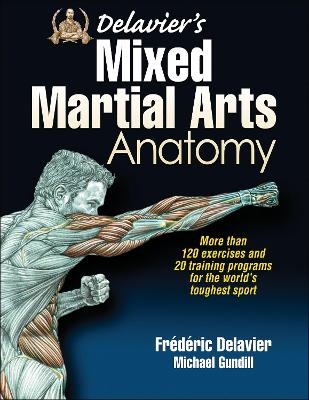
Delavier's Mixed Martial Arts Anatomy
Human Kinetics (Verlag)
978-1-4504-6359-1 (ISBN)
From powerful blows to explosive kicks, Delavier’s Mixed Martial Arts Anatomy takes you inside the action and impact of one of the world’s most popular, grueling, and challenging sports.
Over 230 full-color photos and 120 anatomical illustrations allow you to go inside more than 120 exercises specifically selected for the neuromuscular demands of the sport. You’ll see how muscles interact with surrounding joints and skeletal structures and how variations and sequencing can isolate specific muscles to enhance the full arsenal of combat skills.
Delavier’s Mixed Martial Arts Anatomy features an anatomomorphological approach to allow you to choose the most effective exercises for your body type, physical conditioning, and fighting style. From boxing to ground fighting, you’ll enhance your strengths and minimize your weaknesses with more than 20 proven programs.
Featuring the latest exercises for injury prevention and foam roller techniques for muscle regeneration, it’s all here and all in the stunning detail that only Frédéric Delavier can provide.
Frédéric Delavier is a gifted artist with an exceptional knowledge of human anatomy. He studied morphology and anatomy for five years at the prestigious École des Beaux-Arts in Paris and studied dissection for three years at the Paris Faculté de Médecine. The former editor in chief of the French magazine PowerMag, Delavier is currently a journalist for the French magazine Le Monde du Muscle and a contributor to several other muscle publications, including Men's Health Germany. He is the author of the best-selling Strength Training Anatomy, Women’s Strength Training Anatomy, The Strength Training Anatomy Workout, Delavier's Core Training Anatomy, and Delavier's Stretching Anatomy. Delavier won the French powerlifting title in 1988 and makes annual presentations on the sport applications of biomechanics at conferences in Switzerland. His teaching efforts have earned him the Grand Prix de Techniques et de Pédagogie Sportive. Delavier lives in Paris, France. Michael Gundill has written 13 books on strength training, sport nutrition, and health, including coauthoring The Strength Training Anatomy Workout and The Strength Training Anatomy Workout II. His books have been translated into multiple languages, and he has written over 500 articles for bodybuilding and fitness magazines worldwide, including Iron Man and Dirty Dieting. In 1998 he won the Article of the Year Award at the Fourth Academy of Bodybuilding Fitness & Sports Awards in California. Gundill started weightlifting in 1983 in order to improve his rowing performance. Most of his training years were spent completing specific lifting programs in his home. As he gained muscle and refined his program, he began to learn more about physiology, anatomy, and biomechanics and started studying those subjects in medical journals. Since 1995 he has been writing about his discoveries in various bodybuilding and fitness magazines worldwide.
Part 1
Principles of Strength Training
Developing Your Program
30 Steps to Developing Your Training Program
Purpose of Dividing Training
Techniques for Strength and Power
Eight Principles to Prepare the Muscles for Fighting
Five Types of Strength Most Often Used in Fighting
Secrets of an Effective Strike
Breathing During Strength Training
Adapting Strength Training to the Demands of a Fight
Conditioning and Endurance Techniques
Power and Conditioning: Two Very Different Muscle Qualities
Five Rules for Minimizing Opposition of Power and Endurance
Adjusting Circuits for Optimal Conditioning
Techniques for Increasing Flexibility
Flexibility and Stiffness: Two Opposite Muscle Qualities
When to Stretch
How to Stretch
Techniques for Recovery and Injury Prevention
Warm-Up
Cool-Down
Regenerative Massage Using a Foam Roller
Injury-Causing Strength Imbalances
Cross-Education for Recovery From Injury
Nutritional Approach to Recovery
Part 2
Strength Training Exercises Specifically for Fighting
Neck, Trapezius, and Jaw
Exercises for the Neck
Neck Flexion
Neck Extension
Lateral Neck Flexion
Strengthening the Jaw
Surround Your Neck With Massive Trapezius Muscles
Shrug
Strengthening the Abdominal Wall
Sit-Up
Standing Cable Crunch
Twisting Crunch
Leg Rotation on Pull-Up Bar
Plank
Punches and Elbow Strikes
Exercises for Explosiveness
Narrow-Grip Bench Press
Punch and Elbow Strike With Elastic Band or Pulley
Medicine Ball Throw
Forearms
Wrist Extension
Wrist Curl
Strengthening Your Stance
Partial Squat
Standing Calf Raise
Kicks and Knee Strikes
Paradoxes of the Psoas Muscle
Exercises for Increasing Strength
Standing Leg Lift
Leg Lift on Pull-Up Bar
Knee Strike on All Fours
Grabbing, Pulling, and Choking an Opponent
Pull-Up
Power Triceps Extension
Hanging From Pull-Up Bar
Hammer Curl
Chokes or Countering a Choke
Exercises for Endurance
Hanging From Straps
Isometric Adduction
Leg Press Using Full Range of Motion
Seated Squat
Lying Leg Curl
Reverse Calf Raise
Bridge
How the Muscles of Respiration Affect Endurance
Lying Rib Cage Expansion With Weight
Importance of Hip Flexibility
Hip Rotator Stretch
Lifting and Pulling an Opponent
Conventional Deadlift
Straight-Leg Deadlift
Dumbbell Clean
Row
Part 3
Training Programs
Beginning Programs for Overall Strength
Program for Gaining Familiarity With Strength Training
Program for Increasing Volume of Work
Advanced Beginner Program
Specialized Programs
Basic Specialized Program
Advanced Specialized Program
Highly Advanced Specialized Program
Customized Programs
Boxing Program
Kicking Program
Ground Fighting Program
Hand-to-Hand Fighting Program
Conditioning Circuits
Basic Circuit for Beginners
Intermediate Basic Circuit
Advanced Basic Circuit
Customized Circuits
Boxing Circuit
Kicking Circuit
Ground Fighting Circuit
Hand-to-Hand Fighting Circuit
Specialized Circuits You Can Do at Home
Specialized Circuit for Protecting the Neck
Specialized Circuit for Abdominal Support
Circuits for Injury Prevention
Preventing Shoulder Pain
Preventing Low Back Pain
Preventing Neck Pain
Preventing Hip Pain
Preventing Knee Pain and Hamstring Tears
| Reihe/Serie | Anatomy |
|---|---|
| Verlagsort | Champaign, IL |
| Sprache | englisch |
| Maße | 197 x 254 mm |
| Gewicht | 567 g |
| Themenwelt | Sachbuch/Ratgeber ► Gesundheit / Leben / Psychologie |
| Sachbuch/Ratgeber ► Sport ► Fitness / Aerobic / Bodybuilding | |
| Sachbuch/Ratgeber ► Sport ► Kampfsport / Selbstverteidigung | |
| Studium ► 1. Studienabschnitt (Vorklinik) ► Anatomie / Neuroanatomie | |
| ISBN-10 | 1-4504-6359-2 / 1450463592 |
| ISBN-13 | 978-1-4504-6359-1 / 9781450463591 |
| Zustand | Neuware |
| Haben Sie eine Frage zum Produkt? |
aus dem Bereich


